The Intel Broadwell Desktop Review: Core i7-5775C and Core i5-5675C Tested (Part 1)
by Ian Cutress on June 2, 2015 7:45 AM ESTGaming Benchmarks: Mid-Range
Shifting gears, let's take the iGPU out of the equation and look at gaming from a CPU perspective, By moving up to higher-end video cards, we can being to see how Broadwell stacks up in CPU-bound gaming scenarios.
Alien: Isolation
If first person survival mixed with horror is your sort of thing, then Alien: Isolation, based off of the Alien franchise, should be an interesting title. Developed by The Creative Assembly and released in October 2014, Alien: Isolation has won numerous awards from Game Of The Year to several top 10s/25s and Best Horror titles, ratcheting up over a million sales by February 2015. Alien: Isolation uses a custom built engine which includes dynamic sound effects and should be fully multi-core enabled.
For low end graphics, we test at 720p with Ultra settings, whereas for mid and high range graphics we bump this up to 1080p, taking the average frame rate as our marker with a scripted version of the built-in benchmark.
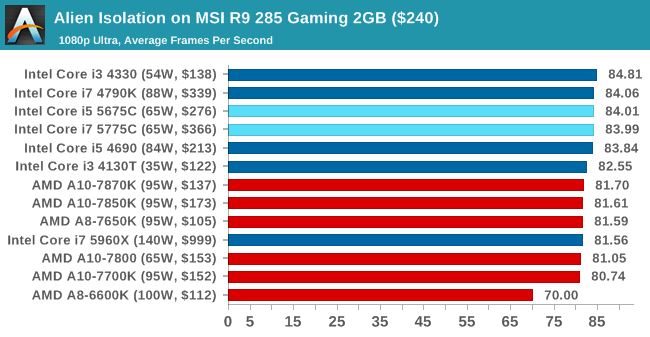
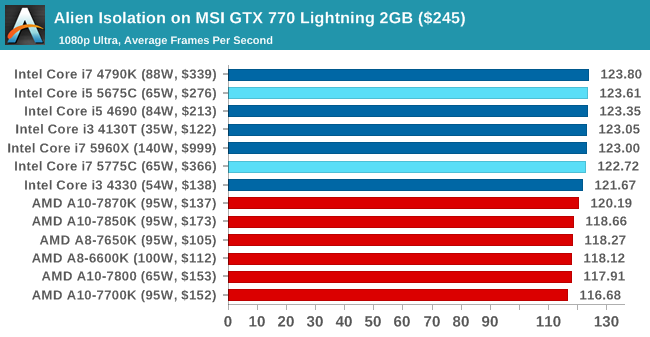
Total War: Attila
The Total War franchise moves on to Attila, another The Creative Assembly development, and is a stand-alone strategy title set in 395AD where the main story line lets the gamer take control of the leader of the Huns in order to conquer parts of the world. Graphically the game can render hundreds/thousands of units on screen at once, all with their individual actions and can put some of the big cards to task.
For low end graphics, we test at 720p with performance settings, recording the average frame rate. With mid and high range graphics, we test at 1080p with the quality setting. In both circumstances, unlimited video memory is enabled and the in-game scripted benchmark is used.
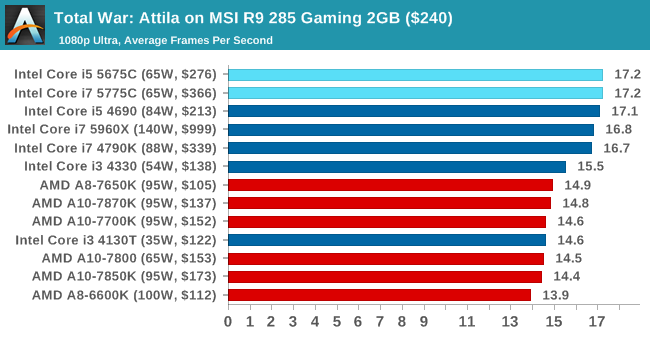
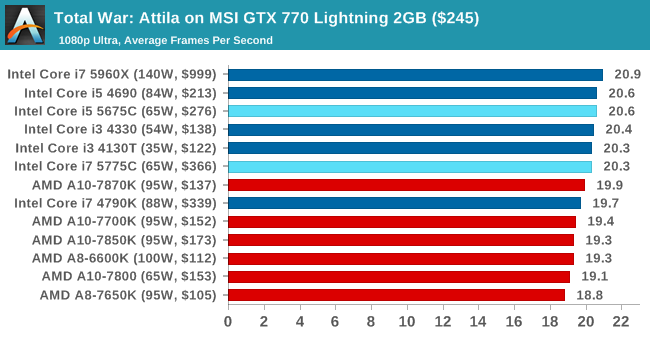
Grand Theft Auto V
The highly anticipated iteration of the Grand Theft Auto franchise finally hit the shelves on April 14th 2015, with both AMD and NVIDIA in tow to help optimize the title. GTA doesn’t provide graphical presets, but opens up the options to users and extends the boundaries by pushing even the hardest systems to the limit using Rockstar’s Advanced Game Engine. Whether the user is flying high in the mountains with long draw distances or dealing with assorted trash in the city, when cranked up to maximum it creates stunning visuals but hard work for both the CPU and the GPU.
For our test we have scripted a version of the in-game benchmark, relying only on the final part which combines a flight scene along with an in-city drive-by followed by a tanker explosion. For low end systems we test at 720p on the lowest settings, whereas mid and high end graphics play at 1080p with very high settings across the board. We record both the average frame rate and the percentage of frames under 60 FPS (16.6ms).
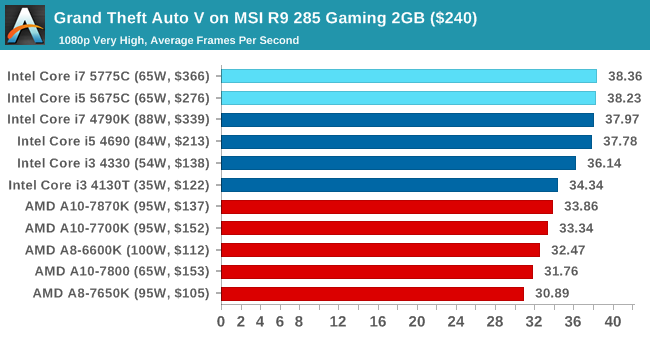
![Grand Theft Auto V on MSI R9 285 Gaming 2GB ($240) [Under 60 FPS]](https://images.anandtech.com/graphs/graph9320/74957.png)
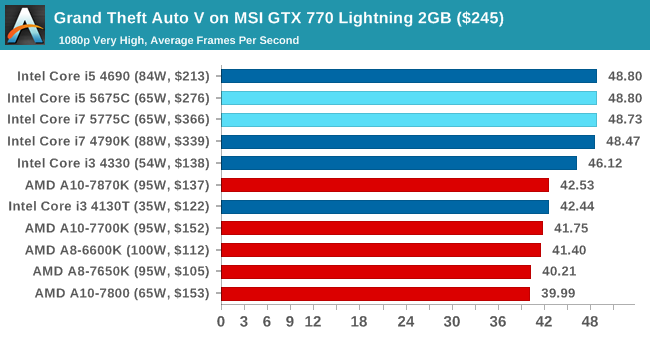
![Grand Theft Auto V on MSI GTX 770 Lightning 2GB ($245) [Under 60 FPS]](https://images.anandtech.com/graphs/graph9320/74967.png)
GRID: Autosport
No graphics tests are complete without some input from Codemasters and the EGO engine, which means for this round of testing we point towards GRID: Autosport, the next iteration in the GRID and racing genre. As with our previous racing testing, each update to the engine aims to add in effects, reflections, detail and realism, with Codemasters making ‘authenticity’ a main focal point for this version.
GRID’s benchmark mode is very flexible, and as a result we created a test race using a shortened version of the Red Bull Ring with twelve cars doing two laps. The car is focus starts last and is quite fast, but usually finishes second or third. For low end graphics we test at 1080p medium settings, whereas mid and high end graphics get the full 1080p maximum. Both the average and minimum frame rates are recorded.

![GRID: Autosport on MSI R9 285 Gaming 2GB ($240) [Minimum FPS]](https://images.anandtech.com/graphs/graph9320/74959.png)
Middle-Earth: Shadows of Mordor
The final title in our testing is another battle of system performance with the open world action-adventure title, Shadows of Mordor. Produced by Monolith using the LithTech Jupiter EX engine and numerous detail add-ons, SoM goes for detail and complexity to a large extent, despite having to be cut down from the original plans. The main story itself was written by the same writer as Red Dead Redemption, and it received Zero Punctuation’s Game of The Year in 2014.
For testing purposes, SoM gives a dynamic screen resolution setting, allowing us to render at high resolutions that are then scaled down to the monitor. As a result, we get several tests using the in-game benchmark. For low end graphics we examine at 720p with low settings, whereas mid and high end graphics get 1080p Ultra. The top graphics test is also redone at 3840x2160, also with Ultra settings, and we also test two cards at 4K where possible.
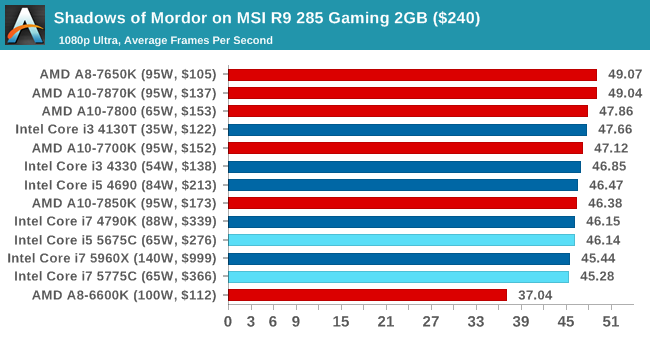
![Shadows of Mordor on MSI R9 285 Gaming 2GB ($240) [Minimum FPS]](https://images.anandtech.com/graphs/graph9320/74961.png)
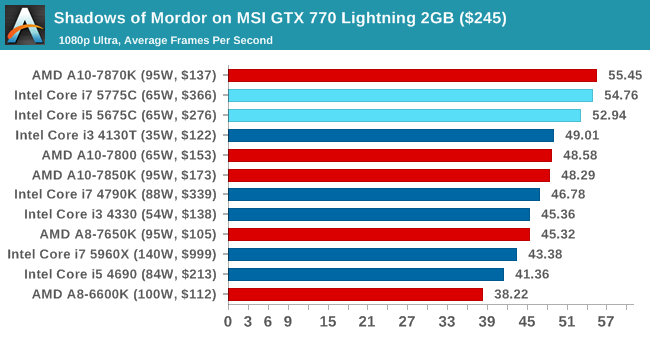
![Shadows of Mordor on MSI GTX 770 Lightning 2GB ($245) [Minimum FPS]](https://images.anandtech.com/graphs/graph9320/74971.png)
Shadows of Mordor at 4K, Single GPU
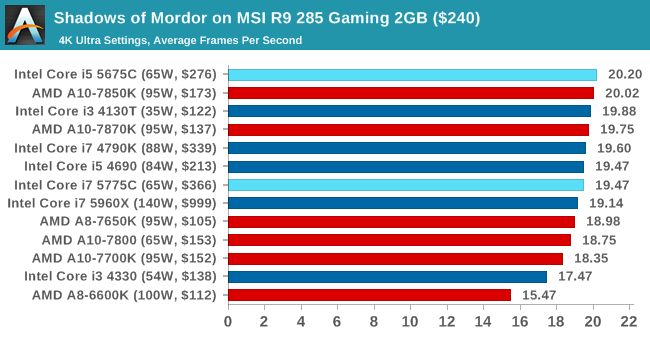
![Shadows of Mordor on MSI R9 285 Gaming 2GB ($240) [Minimum FPS]](https://images.anandtech.com/graphs/graph9320/74963.png)
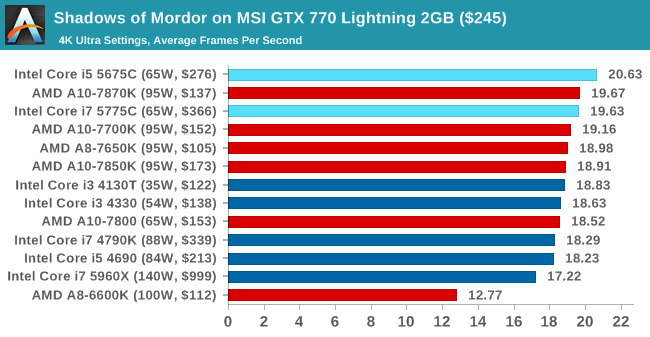
![Shadows of Mordor on MSI GTX 770 Lightning 2GB ($245) [Minimum FPS]](https://images.anandtech.com/graphs/graph9320/74973.png)
Conclusions on Mid-Range Graphics
With the Intel iGPU removed from the picture, what we're seeing here is the combination of Broadwell's architecture improvements, and the Crystal Well eDRAM functioning as an L4 cache for the CPU cores. The biggest benefit here Broadwell-DT was with the R9 285 for GRID on minimum frame rates, showing 75.6 for the 4790K vs 80.06 for the 5775C. Otherwise performance overall is not all that different from what we already see with the best Haswell CPUs, however it's a bit surprising that the Broadwell CPUs don't fall behind, given their rather sizable frequency deficit versus the i7-4790K.















196 Comments
View All Comments
Jumangi - Tuesday, June 2, 2015 - link
Completely worthless release for gamers and PC enthusiasts...another year goes by with no reason to upgrade to a new CPU. Were officially back to the dark days before AMD kicked Intel in the nuts with the Athlon64 and made them have to compete.So sad...
Peichen - Tuesday, June 2, 2015 - link
Skylake is coming in 2 months for gamers. Today's release is for system builders that needs a stopgap. You shouldnt buy into AMD's PR campaign that you need to buy AMD to support innovation. Intel is doing that all by itself.PubFiction - Wednesday, July 1, 2015 - link
I agree 2500K and 2600K here haven't had a single reason to even be tempted to upgrade. The only good that has come of this is that now days I have gobs of cash to spend on GPUs, I guess this explains why NVidia can charge $999 for a GPU now and sell out.jjj - Tuesday, June 2, 2015 - link
Sad that Krzanich continues with this strategy of making products nobody needs and abusing their monopoly to charge way too much.Seriously, just 4 cores and a GPU that can't even do 1080p at those prices? Same die they could have fitted 12 cores and no GPU but we'll never get that because Intel has no interest in making good chips and regulators are all dead.
They'll choke on it, it's unavoidable.
TallestJon96 - Tuesday, June 2, 2015 - link
I only see this being good in all in ones and mini PCs. I fully expect Apple to announce a broadwell refresh for their iMacs before the year ends.Too bad, because I'm looking to upgrade from an i3-2120 to a low-ish power i5, and this fits the bill except that the integrated graphics drive the price through the roof. I'm hoping for a 65w vanilla i5 that performs well, and this is close, but not quite right.
MikhailT - Tuesday, June 2, 2015 - link
I somehow doubt it. They already refreshed the iMac a bit and dropped the prices for the year. They doesn't update as often as everyone else, they're happy to wait.I expect Apple to go full Skylake next year.
Peichen - Tuesday, June 2, 2015 - link
Well, AMD should pay or sue Intel to keep Intel from integrating GT3e GPU into sub $150 CPUs. That would kill all AMD's market above $80.MikhailT - Tuesday, June 2, 2015 - link
WTF, or how about AMD complete to make better stuff instead.Peichen - Tuesday, June 2, 2015 - link
AMD cannot compete. They are so far behind Intel on R&D and even vision and theories it has no chance of catching up to Intel any time soon. The CPU department is kept afloat by the GPU department and that isn't going well either.silverblue - Tuesday, June 2, 2015 - link
AMD doesn't have the money. The main reason it's behind the curve is because they couldn't exactly bring out something to replace Bulldozer and as such had to milk it for all it's worth so it wasn't a complete waste of time that could'v dragged them under. If AMD had the resources, I think we'd have seen a replacement for Bulldozer by now.AMD's GPU tech is hampered by the process node and the lack of eDRAM/HBM. Carrizo may make a large difference in terms of power consumption plus a lesser difference in terms of performance, but AMD stands to benefit a lot from throwing some memory on die. Coupled with better compression, they'll have a more competitive product, but I think Iris Pro 6200 has the leader for the next 12-18 months (even if Carrizo does come to the desktop, will its performance be that much improved over Kaveri? I'm not so sure).
I think we need high quality tests for the iGPUs to see how that makes a difference. Intel may lead by even more.